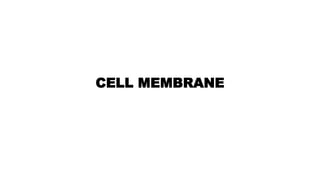
Cell membrane
- 3. • Each cell is surrounded by membrane called Cell membrane or Plasma membrane • Selectively permeable • Thin, pliable, elastic structure • Thickness - average 7.5 to 10 nm thick
- 4. • Composition: It is composed of Protein-55% Phospholipid-25% Cholesterol-13% Other lipids -4% Carbohydrate-3%
- 5. CELL MEMBRANE • The current model of membrane structure: -Fluid mosaic model -By Singer and Nicholson in 1972 • It consists of lipid bilayer and interspersed protein molecules
- 7. 1. LIPID BILAYER • It is a double layered film made up of mainly phospholipid molecules. • Each phospholipid molecule has 2 ends - head end is charged, hydrophilic or polar(phosphate portion)and - the tail end is uncharged, hydrophobic or - nonpolar (the fatty acid portion)
- 8. • Hydrophilic ends face the intracellular water on the inner surface and the extracellular water on the outer surface. • Hydrophobic end meet in the interior of the membrane.
- 9. • Phospholipids are phosphatidylcholine, sphingomyelin and phosphatidyl ethanolamine • Glycolipids are usually found in outer lipid layer • Cholesterol is found incorporated in the hydrophobic region of the cell membrane
- 10. 2. CELL MEMBRANE PROTEINS • Globular masses embedded in the membrane. • Most are glycoproteins. There are 2 types of cell membrane proteins : a)Integral proteins -that pass through the membrane b)Peripheral proteins -attached only to one surface of the membrane
- 11. 3. MEMBRANE CARBOHYDRATES • The entire external surface of the cell membrane is loosely covered by a carbohydrate coat called glycocalyx. • The membrane carbohydrate occurs mostly in combination with proteins (glycoproteins) or in combination with lipids (glycolipids).
- 13. FUNCTION OF CELL MEMBRANE – BILIPID LAYER • Amphipathic • Lipid layer is impermeable to usual charged water soluble substances like ions-[ Na+, K+, Cl- & Ca2+],glucose, and urea. • Fat soluble substances like O2, CO2 ,alcohol & NH3-easily permeable through the membrane. Thus, lipid bilayer acts as a semipermeable membrane • Cholesterol controls much of the fluidity of the membrane.
- 14. FUNCTIONS OF CELL MEMBRANE PROTEINS Integral proteins serves the following functions 1. As ion channels – allows passage of ions across cell membrane 2. Carrier proteins – transport substances along their electrochemical gradient without expenditure of energy 3. Pumps – transport substances against their electrochemical gradient with expenditure of energy 4. Aquaporins –act as water channels
- 16. Peripheral proteins serves the following functions 4. Enzymes - catalyzing reactions at the surface of the membrane 5. Receptors - for specific ligands (neurotransmitters & hormones) 6. Structural proteins - in forming the cell membrane 7. Cell adhesion molecules - that anchors cells to their neighbors or to basal lamina 8. Glycoproteins and glycolipids - function as identity markers eg- ABO antigens, MHC proteins
- 18. • Peripheral proteins are often attached to integral proteins and function mainly as enzymes or controllers of transport of substance through cell membrane.
- 19. FUNCTIONS OF CARBOHYDRATE 1. Many have negative charge and is responsible for negative charge of cell surface. 2. The glycocalyx of some cells attaches to glycocalyx of other cells – thus attaching cells to one another. 3. Many act as receptor substance for binding hormones and then activates enzymes. 4. Some acts as antigens and take part in immune reactions.
- 20. • Maintains the cell volume • In muscle and nerve cells, maintains the potential difference between intracellular and extracellular surfaces.
